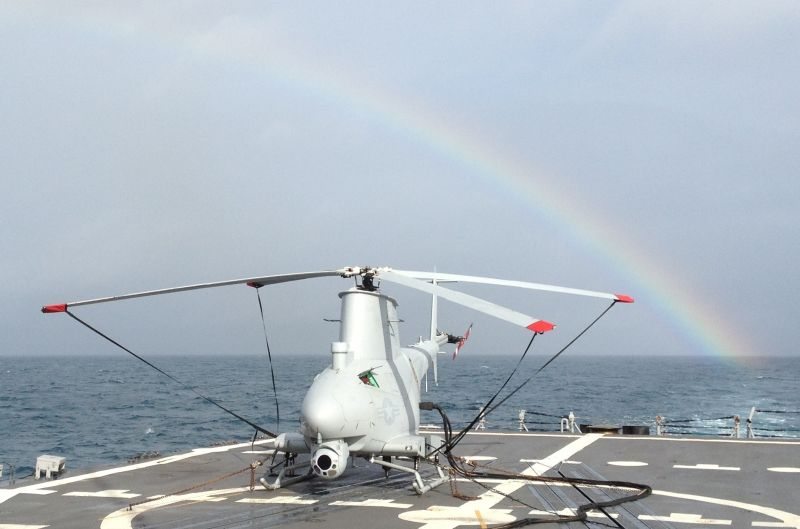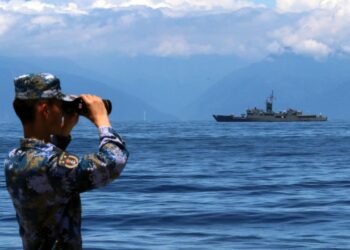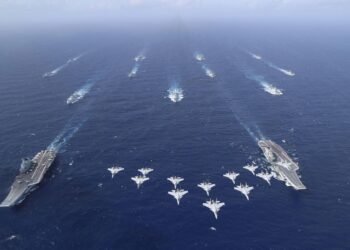Guided-missile frigate USS Simpson (FFG 56) has the Unmanned Aerial Vehicle (UAV), MQ-8B Fire Scout embarked for solo missions, a U.S. Navy first during a full deployment, March 7.
The Fire Scout is the Navy’s only unmanned aircraft to operate on land and at sea. The Fire Scout is a vertical take-off and landing UAV capable of carrying out surveillance, tracking and targeting missions.
Lt. Cmdr. Darren Capo is the officer-in-charge of Helicopter Anti-Submarine Squadron Light Six Zero (HSL-60), the “Jaguars”, the detachment embarked on Simpson that maintains and flies the Fire Scout.
“There are benefits to flying from inside a ship,” said Capo, who’s previously flown the SH-60B Sea Hawk helicopter, about taking on his latest assignment.
Flying the Fire Scout has been a completely new experience, especially physically.
“When you’re done, your ears don’t ring from noise and vibration and you’re not soaked in sweat like you are after flying a long helicopter mission,” said Capo.
Two people operate the Fire Scout during flight, an air vehicle operator (AVO) and a mission payload operator (MPO). Both the AVO and MPO sit at control stations next to each other in the same room.
“Nothing can beat the sensation of flying a helicopter, but flying the Fire Scout is really cool knowing that you’re on the cutting edge of technology,” said Capo.
The AVO is responsible for the overall current mission, navigation and system safety of the Fire Scout’s airframe. The MPO is responsible for operating the Fire Scout’s built-in surveillance camera and communicating with the AVO to get the best shots needed during a mission.
“It’s much like a video game with a trackball, keyboard and two monitors to handle all the open windows,” Capo said about operating the Fire Scout as an AVO. “It’s very interesting if you’re willing to learn new ways of flying.”
Capo also said the future of air warfare will include a large contribution from UAVs.
“The Fire Scout is a truly remarkable piece of equipment that will make its mark on naval aviation for years to come,” said Capo. “The capabilities and freedom from risk of human life are significant benefits to employing the Fire Scout.”
HSL-60 embarked on Simpson with two Fire Scouts and a crew of 15 maintainers; three aircrew act as MPOs and four pilots act as AVOs.
“So far it’s been good working with the Fire Scout’s system,” said Aviation Machinist’s Mate 2nd Class Jonathan Moody, one of HSL-60’s maintainers working with the Fire Scout. “I’m glad to be involved with something that’s part of the Navy’s future and a growing portion of intelligence gathering.”
“I see the Fire Scout as a risk mitigator,” said Moody, who volunteered from his parent command in San Diego to embark with HSL-60 specifically to have a chance to work with the Fire Scout. “It gives you all that you can get from a manned aircraft, but with no exposure to danger for the air crew.”
Moody often works with a laptop right next to the Fire Scout before and after launch and recoveries. He said such interfacing makes his job of running aircraft diagnostics much easier.
“Having a computer to assist with aircraft diagnostics is more maintenance-friendly than without,” said Moody. “It allows you to find problems quickly and easily because all pertinent information is displayed on the monitor right in front of you, at a moment’s notice.”
Moody, like Capo, said he recognizes the larger role UAVs will play in the Navy’s future, but he believes UAVs will not completely replace manned aircraft.
“UAVs should be an addition to the Navy and work alongside manned aircraft,” said Moody, “but we still need manned aircraft for operations like Search and Rescue at sea.”
The Fire Scout was first deployed in 2009 aboard guided-missile frigate, USS McInerney (FFG 8), in 2009. Since then it has exceeded 2,000 hours of real-time intelligence, surveillance and reconnaissance to support U.S. and allied troops in northern Afghanistan.
Simpson, home-ported in Mayport, Fla. is currently conducting theater security cooperation and maritime security operations in the Naval Forces Africa area of responsibility.











